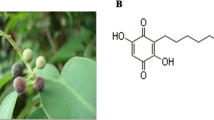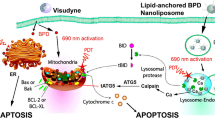Abstract
Photosensitization of tumor cells after incubation with Rose Bengal acetate (RB-Ac) induces multiple organelle photodamage followed by apoptotic cell death. We used immunocytochemical techniques in multicolor fluorescence microscopy to elucidate whether this occurs through the simultaneous activation of different apoptotic pathways, in HeLa cells. We detected in situ the activated forms of caspases 9 and 3, and the translocation from the mitochondria to the nucleus of the apoptosis inducing factor; DNA electrophoretic techniques were also used to assess the occurrence of nuclear DNA cleavage into either high- or low-molecular-weight fragments. Both the caspase-dependent and caspase-independent apoptotic pathways are activated. The genomic DNA is degraded into high molecular weight molecules only, without the formation of oligonucleosome-sized fragments. The ability of RB-Ac to induce the simultaneous release of apoptogenic signals from different photodamaged organelles makes it an especially powerful cytotoxic agent.









Similar content being viewed by others
References
Agostinis P, Vantieghem A, Merlevede W, Witte PAM (2002) Hypericin in cancer treatment: more light on the way. Int J Biochem Cell Biol 34:221–241
Agostinis P, Buytaert E, Breyssens H, Hendrickx N (2004) Regulatory pathways in photodynamic therapy induced apoptosis. Photochem Photobiol Sci 3:721–729
Almeida RD, Manadas BJ, Carvalho AP, Duarte CB (2004) Intracellular signaling mechanisms in photodynamic therapy. Biochim Biophys Acta 1704:59–86
Berg K, Moan J (1997) Lysosomes and microtubules as targets for photochemotherapy of cancer. Photochem Photobiol 65:403–409
Bottiroli G, Croce AC, Balzarini P, Locatelli D, Baglioni P, Lo Nostro P, Monici M, Pratesi R (1997) Enzyme-assisted cell photodsensitization: a proposal for an efficient approach to tumor therapy and diagnosis. The Rose Bengal fluorogenic substrate. Photochem Photobiol 66:74–383
Bottiroli G, Croce AC, Baglioni P, Monici M (2000) Fluorogenic substrates for diagnosis and photodynamic treatment of tumors. US Patent 6,036,941, 14 March 2000
Bottiroli G, Croce AC, Biggiogera M, Lanza KS, Fiorani S, Locatelli D (2001) Photosensitizer damage targets in Rose Bengal acetate treated cells. Laser Surg Med Suppl 13:41
Bottone MG, Soldani C, Fraschini A, Alpini C, Croce AC, Bottiroli G, Pellicciari C (2007) Enzyme-assisted photosensitization with rose Bengal acetate induces structural and functional alteration of mitochondria in HeLa cells. Histochem Cell Biol 127:263–271
Buytaert E, Dewaele M, Agostinis P (2007) Molecular effectors of multiple cell death pathways initiated by photodynamic therapy. Biochim Biophys Acta 1776:86–107
Croce AC, Wyroba E, Bottiroli G (1992) Distribution and retention of rose bengal and disulphonated aluminium phthalocyanine: a comparative study in unicellular eukaryote. J Photochem Photobiol 16:319–330
Croce AC, Supino R, Lanza KS, Locatelli D, Baglioni P, Bottiroli G (2002) Photosensitizer accumulation in spontaneous multidrug resistant cells: a comparative study with Rhodamine 123, Rose Bengal acetate and Photofrin. Photochem Photobiol Sci 1:71–78
Dhale J, Steen HB, Moan J (1999) The mode of cell death induced by photodynamic treatment depends on cell density. Photochem Photobiol 70:363–368
Dhale J, Bagdonas S, Kaathus O, Olsen G, Steen HB, Moan J (2000) The bystander effect in photodynamic inactivation of cells. Biochim Biophys Acta 1475:273–280
Dolmans DE, Fukumura D, Jain RK (2003) Photodynamic therapy for cancer. Nat Rev Cancer 3:380–387
Donzelli M, Bernardi R, Negri C, Prosperi E, Padovan L, Lavialle C, Brison O, Scovassi AI (1999) Apoptosis-prone phenotype of human colon carcinoma cells with a high level amplification of the c-myc gene. Oncogene 18:439–448
Dougherty TJ (2002) An update on photodynamic therapy applications. J Clin Laser Med Surg 20:3–7
Furre IE, Moller MT, Shahzidi S, Nesland JM, Peng Q (2006) Involvement of both caspase-dependent and-independent pathways in apoptotic induction by hexaminolevulinate-mediated photodynamic therapy in human lymphoma cells. Apoptosis 11:2031–2042
Granville DJ, Mcmanus BM, Hunt DW (2001) Photodynamic therapy: shedding light on the biochemical pathways regulating porphyrin-mediated cell death. Histol Histopathol 16:309–317
Hilf R (2007) Mitochondria are target of photodynamic therapy. J Bioenerg Biomembr 39:5–89
Kessel D, Luo Y (1999) Photodynamic therapy: a mitochondrial inducer of apoptosis. Cell Death Differ 6:28–35
Kessel D, Luo Y, Deng Y (1997) The role of subcellular localization in initiation of apoptosis by photodynamic therapy. Photochem Photobiol 65:422–426
Kessel D, Luo Y, Mathieu P, Reiners JJ (2000) Determinants of the apoptotic response to lysosomal photodamage. Photochem Photobiol 71:196–200
Kessel D, Conley M, Vicente MG, Reiners JJ (2005) Studies on the subcellular localization of the porphycene CPO. Photochem Photobiol 81:569–572
Kessel D, Vicente MGH, Reiners JJ Jr (2006) Initiation of apoptosis and autophagy by photodynamic therapy. Lasers Surg Med 38:482–488
Luo Y, Kessel D (1997) Initiation of apoptosis versus necrosis by photodynamic therapy with chloroaluminum phthalocyanine. Photochem Photobiol 66:479–483
Moan J, Berg K (1991) The photodegradation of porphyrins in cells can be used to estimate the lifetime of singlet oxygen. Photochem Photobiol 53:549–553
Morgan J, Oseroff AR (2001) Mitochondria-based photodynamic anti-cancer therapy. Adv Drug Deliv Rev 49:71–86
Neckers DC, Valdes-Aguilera OM (1993) Photochemistry of the xanthene dyes. Adv Photochem 18:315–394
Niedre M, Patterson MS, Wilson BC (2002) Direct near-infrared luminescence detection of singlet oxygen generated by photodynamic therapy in cells in vitro and tissues in vivo. Photochem Photobiol 75:382–391
Oleinick NL, Morris RL, Belichenko I (2002) The role of apoptosis in response to photodynamic therapy: what, where, why, and how. Photochem Photobiol Sci 1:1–21
Panzarini E, Tenuzzo B, Palazzo F, Chionna A, Dini L (2006) Apoptosis induction and mitochondria alteration in human HeLa tumour cells by photoproducts of Rose Bengal acetate. J Photochem Photobiol B Biol 83:39–47
Piette J, Volanti C, Vantieghem A, Matroule JY, Habraken Y, Agostinis P (2003) Cell death and growth arrest in response to photodynamic therapy with membrane-bound photosensitizers. Biochem Pharmacol 15:1651–1659
Soldani C, Scovassi AI (2002) Poly(ADP-ribose) polymerase-1 cleavage during apoptosis: an update. Apoptosis 7:321–328
Soldani C, Bottone MG, Pellicciari C, Scovassi AI (2001a) Two-color fluorescence detection of Poly (ADP-Ribose) Polymerase-1 (PARP-1) cleavage and DNA strand breaks in etoposide-induced apoptotic cells. Eur J Histochem 45:389–392
Soldani C, Lazzè M, Bottone MG, Tognon G, Biggiogera M, Pellicciari C, Scovassi AI (2001b) Poly(ADP-ribose) polymerase cleavage during apoptosis: when and where? Exp Cell Res 269:193–201
Soldani C, Bottone MG, Croce AC, Fraschini A, Bottiroli G, Pellicciari C (2004) The Golgi apparatus is a primary site of intracellular damage after photosensitization with rose Bengal acetate. Eur J Histochem 48:443–448
Soldani C, Bottone MG, Croce AC, Fraschini A, Biggiogera M, Bottiroli G, Pellicciari C (2007) Apoptosis in tumor cells photosensitized with rose Bengal acetate is induced by multiple organelle photodamage. Histochem Cell Biol 128:485–495
Teiten MH, Bezdetnaya L, Morliere P, Santus R, Guillemin F (2003) Endoplasmic reticulum and Golgi apparatus are the preferential sites of Foscan localisation in cultured tumour cells. Br J Cancer 88:146–152
Vermes I, Haanen C, Steffens-Nakken H, Reutelingsperger C (1995) A novel assay for apoptosis Flow cytometric detection of phosphatidylserine expression on early apoptotic cells using fluorescein labelled Annexin V. J Immunol Methods 184:39–51
Vrouenraets MB, Visser GW, Snow GB, van Dongen GA (2003) Basic principles, applications in oncology and improved selectivity of photodynamic therapy. Anticancer Res 23:505–522
Wyld L, Reed MW, Brown NJ (2001) Differential cell death response to photodynamic therapy is dependent on dose and cell type. Br J Cancer 84:1384–1386
Yuste VJ, Sanchez-Lopez I, Solé C, Moubarak RS, Bayaskas JR, Dolcet X, Encinas M, Susin SA, Comella JX (2005) The contribution of Apoptosis-inducing factor, caspases-activated DNase, and inhibitor of caspase-activated DNase to the nuclear phenotype and DNA degradation during apoptosis. J Biol Chem 280:35670–35683
Acknowledgments
We acknowledge the following Italian institutions for supporting our research: MIUR (PRIN project no. 2005058254), University of Pavia (FAR grant 2007) and Regione Lombardia (Project Metadistretti n. 4238). Confocal images were taken at the Centro Grandi Strumenti of the University of Pavia.
Author information
Authors and Affiliations
Corresponding author
Rights and permissions
About this article
Cite this article
Bottone, M.G., Soldani, C., Fraschini, A. et al. Enzyme-assisted photosensitization activates different apoptotic pathways in Rose Bengal acetate treated HeLa cells. Histochem Cell Biol 131, 391–399 (2009). https://doi.org/10.1007/s00418-008-0538-0
Accepted:
Published:
Issue Date:
DOI: https://doi.org/10.1007/s00418-008-0538-0




